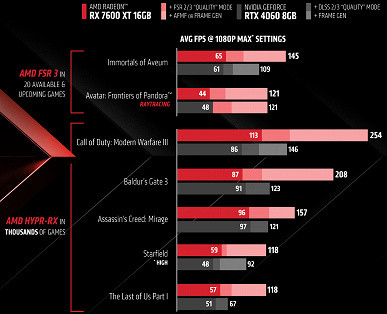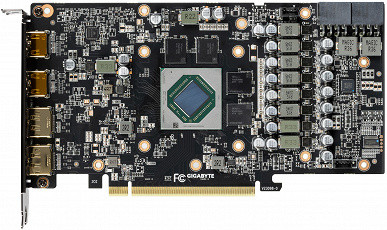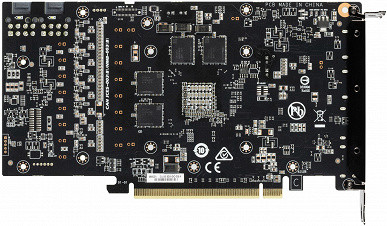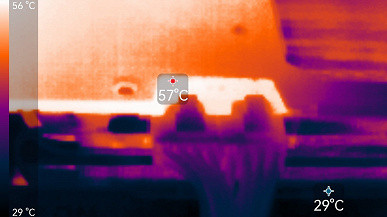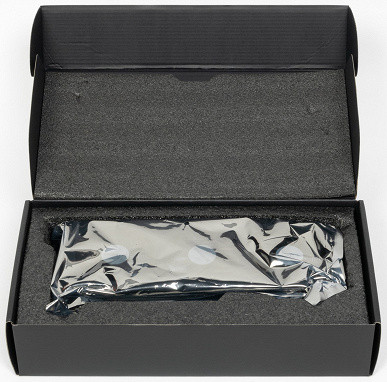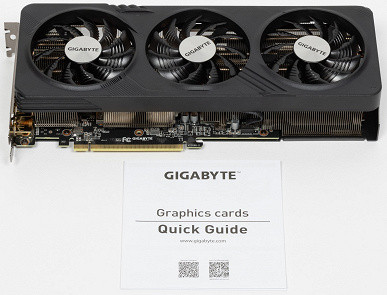General information about Radeon RX 7600 XT
Reviews of video cards of the Radeon RX 7000 family are almost complete, but there remains one model released back in January of this year. The AMD line of video cards was released not quite according to the standard schedule. First, we presented a review of the younger of the two flagship models — the Radeon RX 7900 XT, in which we spoke in detail about the architectural changes to RDNA3 and the features of the new AMD video cards. Next we looked at the top-of-the-line Radeon RX 7900 XTX. Unlike the usual order, after the flagships there was not a mid-price model, but a budget video card Radeon RX 7600, and the Radeon RX 7800 XT and Radeon RX 7700 XT appeared on the market later.
Today we will look at a model very close to the Radeon RX 7600 with the XT suffix. This video card was presented at CES 2024 in early January and took an intermediate place between the Radeon RX 7600 and Radeon RX 7700 XT. The model without the XT suffix was released simultaneously with the GeForce RTX 4060 Ti, and both of them are designed for gaming in Full HD resolution, but the AMD solution is lower in level and price, competing with the GeForce RTX 4060, which appeared on the market later. The XT version of the Radeon RX 7600 occupies a middle position between the GeForce RTX 4060 and GeForce RTX 4060 Ti. The complete line of Radeon RX 7000 video cards is as follows:
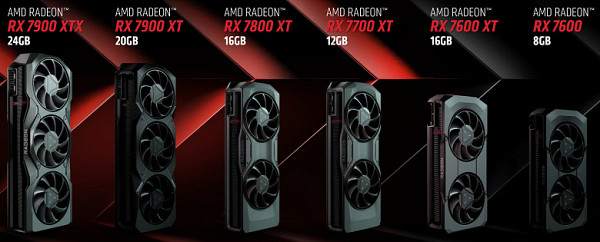
Theoretically, to create the Radeon RX 7600 XT, it would be possible to use a greatly reduced version of Navi 32 with a chiplet layout. However, this would be too expensive for this price segment, especially in the absence of a large number of defective chips, which chiplets are designed to work with. Therefore, for a solution costing $329, we took the same monolithic Navi 33 crystal, known to us from the younger model without the XT suffix. This chip is based on the RDNA3 graphics architecture, like the older models in the series, but it is a single die, since for simple GPUs there is no point in breaking it into smaller parts.
But what if the non-XT Radeon RX 7600 model already uses the GPU variant with all execution units active? It is impossible to “unblock” disabled blocks; all that remains is to increase the clock frequencies. However, the Radeon RX 7600 XT differs from the Radeon RX 7600 not only in its slightly faster GPU with the same number of execution units, but also in the doubled amount of video memory, which led to a price increase of $60. Since the Radeon RX 7600 XT is positioned closer to the GeForce RTX 4060, it has a recommended price close to this model.
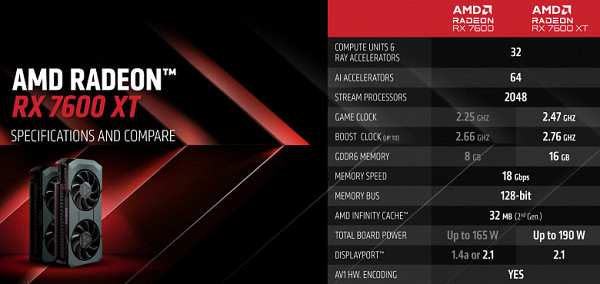
The comparison table shows that the differences between the Radeon RX 7600 and Radeon RX 7600 XT are insignificant: only the chip frequencies and the amount of video memory have been increased. The Radeon RX 7600 XT with 16 GB of memory is also designed for gaming in Full HD resolution (sometimes 2560x1440) at maximum quality settings, including ray tracing, like its younger version. This video card is aimed at upgrading users with outdated gaming systems. The price range of about $300 attracts the attention of all companies, since it is one of the most popular.
According to AMD, about 65% of gamers use Full HD resolution and have outdated graphics cards. The company is offering a new model to meet the needs of these gamers who are using something like the GeForce RTX 2060 or Radeon RX 5600 XT. In this context, the Radeon RX 7600 XT with increased memory looks attractive, allowing you to play even at 2560x1440 resolution, although not all games. The new card supports ultra-high resolution and frame rate output via DisplayPort 2.1 and full AV1 video encoding, although this is less important.
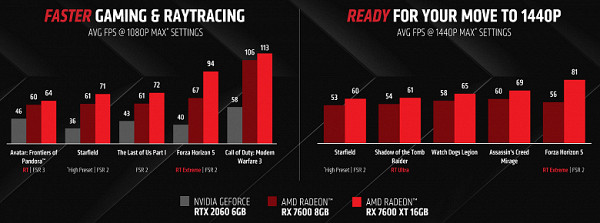
GeForce RTX 2060 owners will see a significant performance boost when upgrading to the Radeon RX 7600 XT, according to AMD — more than double the speedup, including playable ray tracing. The GeForce RTX 2060 is a common video card, but in modern games at high settings, even in Full HD resolution, it often does not provide the required performance. A new graphics card with a higher level of performance may push users to upgrade. However, keep in mind that AMD's data uses FSR technology, which involves rendering at a lower resolution and scaling it to a higher resolution, and sometimes generating additional frames.
The release of the Radeon RX 7600 XT was important for AMD, as the GeForce RTX 4060 provided significantly better performance at only a slightly higher price. Since AMD could not increase the number of execution units in the already fully used Navi 33, it was necessary to increase the GPU frequency and double the amount of video memory. The Radeon RX 7600 XT uses double-density memory chips, as does the 16GB GeForce RTX 4060 Ti. It's important to understand whether doubling the video memory to 16GB will have a noticeable impact on overall performance. We'll look at this today.
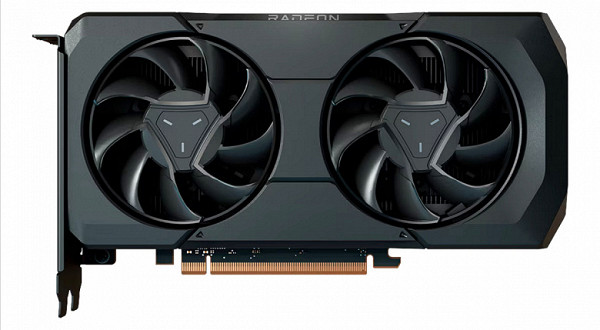
| Radeon RX 7600 XT graphics accelerator | |
|---|---|
| Chip code name | Navi 33 |
| Production technology | 6 nm (N6 TSMC) |
| Number of transistors | 13.3 billion |
| Core area | 204 mm² |
| Architecture | unified, with an array of processors for stream processing of any type of data: vertices, pixels, etc. |
| DirectX hardware support | DirectX 12 Ultimate, supporting Feature Level 12_2 |
| Memory bus | 128-bit: 2 independent 64-bit memory controllers with GDDR6 support |
| GPU frequency | up to 2760 MHz |
| Computing blocks | 32 CUs consisting of a total of 2048 ALUs for integer and floating point calculations (INT4, INT8, INT16, FP16, FP32 and FP64 formats supported) |
| Ray tracing blocks | 32 Ray Accelerator blocks for calculating the intersection of rays with triangles and BVH bounding volumes |
| Texturing blocks | 128 texture addressing and filtering units with support for FP16/FP32 components and support for trilinear and anisotropic filtering for all texture formats |
| Raster Operation Blocks (ROPs) | 8 wide ROP blocks of 64 pixels with support for various anti-aliasing modes, including programmable and for FP16/FP32 frame buffer formats |
| Monitor support | support for HDMI 2.1b and DisplayPort 2.1 interfaces |
| Radeon RX 7600 XT Reference Graphics Card Specifications | |
|---|---|
| Core Clock (Gaming/Turbo) | 2470/2760 MHz |
| Number of universal processors | 2048 |
| Number of texture blocks | 128 |
| Number of blending blocks | 64 |
| Effective memory frequency | 18 GHz |
| Memory type | GDDR6 |
| Memory bus | 128 bit |
| Memory | 16 GB |
| Memory Bandwidth | 288 GB/s |
| Compute Performance (FP32) | up to 22.6 teraflops |
| Theoretical maximum fill rate | 177 gigapixels/s |
| Theoretical texture sampling rate | 353 gigatexels/s |
| Tire | PCI Express 4.0 x8 |
| Connectors | one HDMI 2.1b, two DisplayPort 2.1 and one USB Type C |
| Energy consumption | up to 190 W |
| Additional food | two 8-pin connectors |
| Number of slots occupied in the system case | 2 |
| Recommended price | $329 |
The name of the new video card model corresponds to the principle adopted several years ago: the model, one step higher than the youngest video card in the line, was called Radeon RX 7600 XT. We were already surprised that even the Radeon RX 7600 is based on the full version of the Navi 33 GPU, and there is no reserve left for the Radeon RX 7600 XT. Considering all the changes between the two graphics cards on this GPU, the Radeon RX 7600 XT might be better called «Radeon RX 7600 16GB». The Radeon RX 7600 was probably originally planned with fewer active units, but stiff competition from Nvidia forced a change in the GPU configuration.
The recommended price for the Radeon RX 7600 XT is $329. Let us remember that the initial price of the Radeon RX 7600 was planned at $299, but due to the release of the GeForce RTX 4060 for $299, it had to be reduced to $269. Thus, the main rival for the Radeon RX 7600 XT is the GeForce RTX 4060, which sells in Western markets for $300 or less, providing noticeably higher ray tracing performance and support for DLSS 3 technology, superior to FSR 3 in quality. While ray tracing speed may not be as important at this price point, the GeForce RTX 4060 Ti, which is much faster and allows for ray tracing in games, sells for around $400. This is significantly more than $330, but new technologies may attract buyers.
The most interesting question concerns the amount of video memory. With a 128-bit video memory bus width, the choice was between 8 and 16 GB, and the smaller amount is already occupied by the Radeon RX 7600. AMD emphasizes the importance of video memory for modern games, even at relatively low resolutions and at non-maximum quality settings, so for the XT option chose 16 GB. To double the memory, AMD did what Nvidia did with the 16GB GeForce RTX 4060 Ti, but added $60 to the price instead of $100. This is a controversial decision, because 8 GB is still enough for a budget video card. Some games can use up to 10-12 GB of VRAM, but increasing the amount of memory alone is unlikely to be enough to significantly improve performance. However, 16 GB is more promising than 8 GB or 12 GB of other solutions at this level, if you look into the future.
The changed energy consumption is also interesting — naturally, upward. Double the memory and higher GPU clocks have led to increased power consumption, with the Radeon RX 7600 XT consuming up to 190 W compared to 165 W for the regular model. The previous generation Radeon RX 6600 XT had a TDP of 160 W. With such consumption, the new model on Navi 33 is probably still more energy efficient than video cards of the previous generation, but is inferior to older solutions in this series and GeForce video cards of a similar level. Even the more powerful GeForce RTX 4060 Ti consumes noticeably less energy.
This level of consumption can be achieved using a PCIe slot and one additional 8-pin power connector, but the Radeon RX 7600 XT has two such connectors installed. Unlike older and younger models, AMD itself does not have a reference version of the video card. The design of the board itself is there, but it was not planned for sale in this form. AMD partners have released a variety of models with different designs, sizes, lighting and cooling systems, some of which are factory overclocked and have increased levels of power consumption and performance. Since January, Radeon RX 7600 XT video cards have been available at retail from ASRock, Asus, Acer, Gigabyte, Sapphire, PowerColor, XFX and others.
Architecture Features
We examined the RDNA3 graphics architecture in detail in our review of the Radeon RX 7900 XT. In this material we will only briefly dwell on the main points and features of the video card in question. For the Radeon RX 7600 XT, it would be possible to use a greatly reduced version of Navi 32, but this would be too expensive for AMD, since the chiplet layout cannot be cheap at the current stage of technology development. For solutions priced around $300, such as the competing GeForce RTX 4060 based on the small AD107 GPU, a monolithic crystal with a simpler configuration — Navi 33 — is better suited.
The RDNA3 architecture is an improved version of the previous architecture. Major changes include:
- Possibility of simultaneous launch of two instructions for execution in computing units.
- Optimizations for more complete use of resources.
- Support for new mathematical formats and acceleration of AI calculations.
- Improved hardware ray tracing blocks.
In RDNA3, AI acceleration blocks repurpose SIMD32 modules to perform matrix calculations instead of conventional FP32/FP16 operations. BF16 and INT8 formats are supported and perform twice as fast as FP32.
The ray tracing accelerators in RDNA2 were less efficient than those of the competitor. RDNA3 improves ray tracing performance by 80% with more accelerators, hardware optimizations, and higher GPU clock speeds.
In the younger RDNA3 solution, such as the Radeon RX 7600 XT, the register file size is reduced — 128 KB per SIMD compared to 192 KB for older GPUs. Navi 33 has 8 MB vector registers, while Navi 31 has 36.8 MB. This may reduce performance for a large number of computational tasks, but should not be an issue when rasterizing.
Navi 33 is the simplest implementation of RDNA3. For budget GPUs, it makes no sense to separate computational units and other functional units on different chips, as in the older Navi 31 and 32 models. A monolithic crystal has its advantages: reduced access latencies to cache and video memory thanks to on-chip connections, which are faster than inter-chip connections.
Navi 33 is manufactured using TSMC's 6nm process technology, which makes it simpler than older 5nm chips. The crystal contains 13.3 billion transistors and has an area of 204 mm². This process technology is also used in the I/O chiplets of Zen 4 processors and memory controllers in older GPUs.
The energy efficiency of the Radeon RX 7600 XT is not much improved compared to the Radeon RX 6600 XT, since the 6nm process technology does not provide performance gains or lower power consumption compared to 7nm, but only provides higher transistor density. Compare the 13.3 billion transistors in 204 mm² of the Navi 33 with the AD106 die (GeForce RTX 4060 Ti), which consists of 22.9 billion transistors and has an area of 190 mm² thanks to the 5 nm process technology — the difference is almost double.
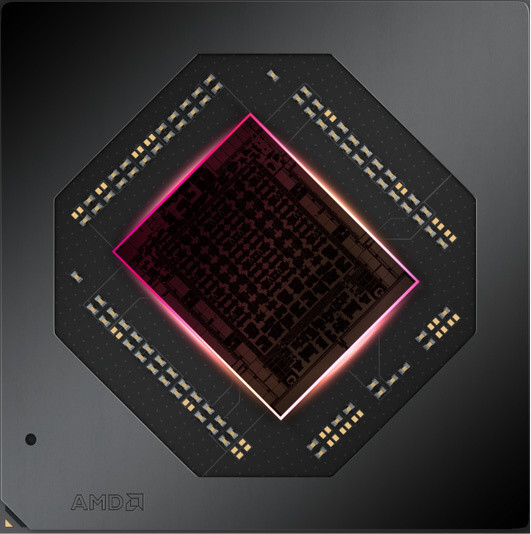
The Navi 33 chip contains two shader engines, each with eight dual RDNA3 units (16 CUs in total) that share rasterization units. Geometry processors and asynchronous engines are also shared between shader engines. Overall, the Navi 33 GPU is very similar to the Navi 23 from the previous generation, in terms of the number of blocks, memory bus and other parameters. The memory subsystem remains almost unchanged compared to its predecessors in the Radeon 6000 series — the same GDDR6 chips connected via a 128-bit interface, but now they operate at an effective clock speed of 18 Gbps, and the Infinity Cache has become faster.
The graphics processor used in the Radeon RX 7600 XT is identical to that used in the Radeon RX 7600 — this is the same Navi 33 with a full set of execution units: 32 RDNA 3 compute units, including 2048 stream processors, 64 artificial intelligence accelerators, 32 trace accelerators rays, 128 texture units (TMU) and 64 raster operation units (ROP). Video memory bandwidth remains the same — 288 GB / s, but the amount of video memory has been doubled, which in memory-demanding games can increase frame rates by up to 20% or more, but only in certain projects and at high resolutions.
The main changes affected the GPU frequency: game and turbo frequencies were increased from 2.25 and 2.66 GHz to 2.47 and 2.76 GHz, respectively. This represents a 10% and 4% boost in frequency respectively over the Radeon RX 7600, which should result in some performance improvements. The gaming frequency is more important than the maximum frequency, since this is where the GPU operates most of the time, so a performance increase of up to 10% is quite expected. The maximum power consumption has also increased, which allows the GPU to operate at higher frequencies without limiting power consumption.
Like the younger model, the Radeon RX 7600 XT supports only eight PCIe 4.0 lanes, which reduces the peak interface bandwidth by half compared to older GPUs. However, this should be enough for the budget segment. Fewer PCIe lanes save on die area as I/O interfaces take up significant space when transitioning to more advanced process technologies. On modern platforms with PCIe 4.0 support, eight lanes of bandwidth will be equivalent to PCIe 3.0 x16 of previous generations, although bandwidth may be limited on older platforms.
The Radeon RX 7600 XT has 16GB of video memory, which is unusual for graphics cards in the $300 price range. This is an advantage from a technical point of view, but controversial from a market point of view. Even if a game uses more than 8 GB of video memory, this increase does not always lead to an improvement in comfort and frame rate, since not all loaded resources are used constantly. If there is insufficient video memory, games may experience reduced texture and geometry quality, which may have a slight impact on performance. However, in cases where lack of memory significantly reduces performance, the difference between the 8GB and 16GB models is easier to see.
From the point of view of future games, 16 GB of memory is more promising, since modern games sometimes require more than 8 GB, and in the future there will be more such games. An example would be the GeForce GTX 1060 with 3 GB and 6 GB or the Radeon RX 570/580 with 4 GB and 8 GB, where models with more memory perform better in modern games.
The display subsystem in the Radeon RX 7000 has been significantly improved compared to the previous generation. All hardware capabilities for encoding and decoding video formats from older solutions are available in Navi 33, including support for AV1 and SmartAccess Video. The Navi 33 GPU is capable of encoding and decoding AV1 video data at 8K resolution at 60 FPS. The new Radiance Display Engine supports DisplayPort 2.1 with UHBR 10 and UHBR 13.5 data rates, twice the speed of DisplayPort 1.4. This allows you to connect 4K displays with refresh rates up to 240 Hz without compressing the video stream, and with compression you can use 4K at 480 Hz or 8K at 165 Hz. This is an advantage over Nvidia solutions, which are limited to DisplayPort 1.4a. AMD requires DisplayPort 2.1 connectors to be installed at all partners for the Radeon RX 7600 XT, whereas this was optional for the Radeon RX 7600.
Preliminary Performance Assessment
Let's look at the characteristics of the new AMD video card compared to similar solutions from the previous generation. The Radeon RX 7600 XT is comparable in power to the Radeon RX 6600 XT or Radeon RX 6650 XT, but we included the more powerful Radeon RX 6700 in the table as it is still available on the market at a similar price. The table will help you evaluate how the second-from-bottom model of the Radeon RX 7000 line compares with previous generation video cards in terms of theoretical characteristics.
| RX 7600XT | RX 7600 | RX 6700 | RX 6650XT | RX 6600XT | RX 6600 | |
|---|---|---|---|---|---|---|
| GPU model | Navi 33 | Navi 33 | Navi 22 | Navi 23 | Navi 23 | Navi 23 |
| Technical process, nm | 6 | 6 | 7 | 7 | 7 | 7 |
| Number of transistors, billion | 13.3 | 13.3 | 17.2 | 11.1 | 11.1 | 11.1 |
| Area, mm² | 204 | 204 | 336 | 237 | 237 | 237 |
| Computer processors | 32 | 32 | 36 | 32 | 32 | 28 |
| Stream processors | 2048 | 2048 | 2304 | 2048 | 2048 | 1792 |
| RT cores | 32 | 32 | 36 | 32 | 32 | 28 |
| TMU blocks | 128 | 128 | 144 | 128 | 128 | 112 |
| ROP blocks | 64 | 64 | 64 | 64 | 64 | 64 |
| Turbo frequency, MHz | 2760 | 2625 | 2450 | 2635 | 2589 | 2491 |
| Video memory frequency, GHz | 18 | 18 | 16 | 18 | 16 | 14 |
| Video memory capacity, GB | 16 | 8 | 10 | 8 | 8 | 8 |
| Video memory bus, bit | 128 | 128 | 160 | 128 | 128 | 128 |
| Infinity Cache, MB | 32 | 32 | 80 | 32 | 32 | 32 |
| PSP, GB/s | 288 | 288 | 320 | 288 | 256 | 224 |
| Performance FP32, Tflops | 22.6 | 21.5 | 11.3 | 10.8 | 10.6 | 8.9 |
| Consumption, W | 190 | 165 | 175 | 180 | 160 | 132 |
| Recommended price, $ | 329 | 269 | 479 | 399 | 379 | 329 |
Like the Radeon RX 7600, the XT variant is close in most characteristics to the Radeon RX 6600 XT and Radeon RX 6650 XT. The Radeon RX 6700 has more execution units and is based on GPUs from a higher price range. The theoretical computing speed of the Radeon RX 7600 (XT) is significantly higher, but in practice the difference is not so great: for example, the Radeon RX 7900 XT is theoretically twice as fast as the Radeon RX 6950 XT, but in games its advantage is only about 20% on average. So the Radeon RX 7600 XT will not significantly exceed the Radeon RX 6650 XT in terms of peak computing performance.
In other respects, the Radeon RX 7600 XT is not particularly faster than the previous generation. Although it has more GDDR6 memory, the bandwidth remains on par with the Radeon RX 6650 XT. This is explained by the fact that the N6 process technology from TSMC is only an improved version of the N7 used in the production of Navi 23. The transistor density has increased by one and a half times, but this is still less than that of the older Navi 31 and Navi 32 chips.
AMD compares this model to the GeForce RTX 2060 and GeForce RTX 4060, skipping the GeForce RTX 3060, but using FSR and DLSS, including extra frame generation, making such comparisons moot. According to AMD, the Radeon RX 7600 XT is on average slightly faster than the GeForce RTX 4060, gaining about 8% in Full HD resolution at maximum settings and using FSR/DLSS. At 2560x1440 the frame rate difference becomes even greater, with the Radeon RX 7600 XT leading by 10% on average. However, when using FSR and DLSS, it is worth considering not only the speed, but also the image quality, where DLSS has it higher.
With the Radeon RX 7600 XT, playing modern games at Full HD resolution has become much more comfortable compared to previous generations of video cards, especially those with less video memory, which sometimes affects performance. It is also possible to increase the rendering resolution to 2560x1440, but using FSR technology, which is now available on Radeon, making them more universal for different generations of GPUs.
With 16GB of video memory, the Radeon RX 7600 XT outperforms most similar graphics cards from previous generations (such as the Radeon RX 6600 XT and Radeon RX 6600), as well as many of Nvidia's rival solutions. While this may not be a significant benefit for most games at Full HD resolution, some new games such as Resident Evil, Hogwarts Legacy, The Last of Us Part I and Jedi Survivor already benefit from this amount of memory to benefit the Radeon RX 7600 XT over other video cards. However, this comes at a price: a $60 price increase, which slightly worsens the price/performance ratio.
The increased memory will also come in handy in artificial intelligence applications, where the Radeon RX 7600 XT can provide up to a 20% to 30% increase in performance compared to models with less memory, especially when running larger models. Some memory-intensive AI tasks may not run at all on graphics cards with 8GB of memory.

Unfortunately, new Nvidia and AMD graphics cards in this price range do not provide significant performance gains over previous generations of GPUs. The Radeon RX 7600 XT is priced just above $300, but there are plenty of graphics cards available on the market that are either more powerful or more affordable, including the Radeon RX 6700 (XT). Therefore, the question of what the new generation offers compared to the previous one remains open.
While DisplayPort 2.1 support and AV1 video encoding are positive innovations, their relevance is currently questionable. Increased video memory will be useful in the future, but you will have to pay for it now. However, the Radeon RX 7600 XT offers future-proofing for more demanding games, and if you're planning on buying the card for the long haul, the extra $60 may be worth it.
However, other than this, the Radeon RX 7600 XT does not have any clear advantages over previous GPU models, which is why it did not become a bestseller. It's suitable for Full HD gaming at maximum settings, and compared to the Radeon RX 7600 we see a definite boost. However, whether this model is worth the extra payment remains an open question.
Independent tests show that the Radeon RX 7600 XT is on average faster than the Intel Arc 770 and GeForce RTX 3060, but is inferior to the Radeon RX 6700 XT and GeForce RTX 4060 at Full HD resolution at maximum graphics settings. For the sake of it, the RX 7600 XT also consumes more power compared to the Radeon RX 7600, and the power consumption even exceeds the GeForce RTX 4070. This can be an issue on older systems.
In general, the Radeon RX 7600 XT can deliver around 60 FPS in Full HD resolution at maximum graphics settings, but some games will require lowering the ray tracing settings. It can also provide a comfortable gaming experience at 2560x1440 resolution at high or maximum settings, mainly thanks to the large amount of video memory. However, the Radeon RX 7600 XT has disadvantages, such as being limited to PCI Express connectivity with only 8 lanes and high power consumption.
Thus, an increase in memory and a slight increase in frequency are the main differences between the Radeon RX 7600 XT and the Radeon RX 7600. It may be slightly better than its younger model, but comparison with the GeForce RTX 4060 and A770 does not allow us to clearly select a winner.
Features of the Gigabyte Radeon RX 7600 XT Gaming OC 16G (16 GB) card
Founded in 1986 in Taiwan, Gigabyte Technology originally started as a group of developers and researchers. In 2004, it became part of the Gigabyte holding, including Gigabyte Technology, responsible for the development and production of video cards and motherboards for PCs, as well as Gigabyte Communications, specializing in the production of communicators and smartphones under the GSmart brand since 2006.
The object of the study is the Gigabyte Radeon RX 7600 XT Gaming OC 16G video card with 16 GB of GDDR6 memory and a 128-bit data bus.


| Gigabyte Radeon RX 7600 XT Gaming OC 16G 16GB 128-bit GDDR6 | ||
|---|---|---|
| Parameter | Meaning | Nominal value (reference) |
| GPU | Radeon RX 7600 XT (Navi33) | |
| Interface | PCI Express x8 4.0 | |
| GPU operating frequency (ROPs), MHz | 2810(Boost)—2750(Max) | 2755(Boost)—2790(Max) |
| Memory operating frequency (physical (effective)), MHz | 2238 (17904) | 2238 (17904) |
| Memory bus width, bits | 128 | |
| Number of computational units in the GPU | 32 | |
| Number of operations (ALU/CUDA) in block | 64 | |
| Total number of ALU/CUDA blocks | 2048 | |
| Number of texturing units (BLF/TLF/ANIS) | 128 | |
| Number of rasterization units (ROP) | 64 | |
| Number of Ray Tracing blocks | 32 | |
| Number of tensor blocks | — | |
| Dimensions, mm | 280×115×53 | 205×115×40 |
| Number of slots in the system unit occupied by a video card | 3 | 2 |
| PCB color | black | black |
| Peak power consumption in 3D, W | 204 | 190 |
| Power consumption in 2D mode, W | 22 | 22 |
| Energy consumption in sleep mode, W | 4 | 4 |
| Noise level in 3D (maximum load), dBA | 31.7 | 36.0 |
| Noise level in 2D (video viewing), dBA | 18.0 | 18.0 |
| Noise level in 2D (idle), dBA | 18.0 | 18.0 |
| Video outputs | 2×HDMI 2.1, 2×DisplayPort 2.1 | 1×HDMI 2.1, 3×DisplayPort 2.1 |
| Multiprocessing support | No | |
| Maximum number of receivers/monitors for simultaneous image output | 4 | 4 |
| Power: 8-pin connectors | 2 | 1 |
| Power: 6-pin connectors | 0 | 0 |
| Power: 16-pin connectors | 0 | 0 |
| Weight of the card with delivery set (gross), kg | 1.27 | 1.1 |
| Card weight (net), kg | 0.94 | 0.76 |
| Maximum resolution/frequency, DisplayPort | 3840×2160@144 Hz, 7680×4320@60 Hz | |
| Maximum resolution/frequency, HDMI | 3840×2160@144 Hz, 7680×4320@60 Hz |
Memory
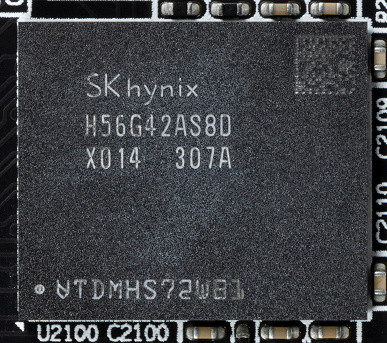
The video card contains 16 GB of GDDR6 SDRAM memory, divided between 8 16 Gbit chips located on the front and back sides of the PCB. Memory chips from SKhynix (H56G42AS8DX014) are designed to operate at a frequency of 2500 (20000) MHz.
Card features and comparison with Gigabyte Radeon RX 7600 Gaming OC (8 GB)
We naturally compare the new product with a product one level lower (Radeon RX 7600) from the same manufacturer. Both cards use the same cores; their differences lie mainly in the GPU operating frequency and permissible power consumption limits. In addition, both cards have a 128-bit bus for exchanging data with memory, and their memory frequency is the same. The differences mainly concern the power system: the Radeon RX 7600 XT requires two power connectors and has an additional 4 memory chips on the reverse side. However, it should be noted that the presence of eight memory chips does not mean a 256-bit memory bus; the width remains 128 bits, only parallel access to two chips occurs, since the GPU memory controller still remains 128-bit.
The graphics card core has an encrypted digital marking indicating week 42 of 2023 production.
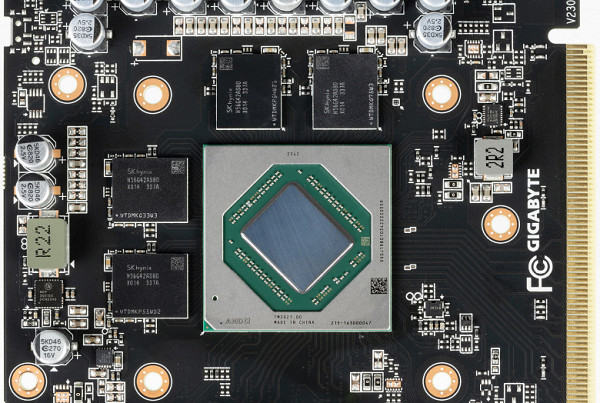
The total number of power phases for the Gigabyte Radeon RX 7600 XT Gaming OC 16G card is 10 (8+2).
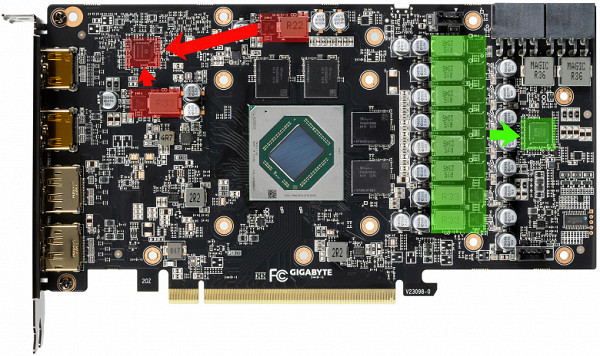
On the front side of the graphics card's printed circuit board, the power supply circuit for the core is highlighted in green, and the memory circuit is highlighted in red. All PWM controllers (pulse width modulators) are located on this side of the board.
To control the 8 phases of core power, the IR35217 PWM controller from Infineon is used. This controller is capable of controlling up to 8 phases.
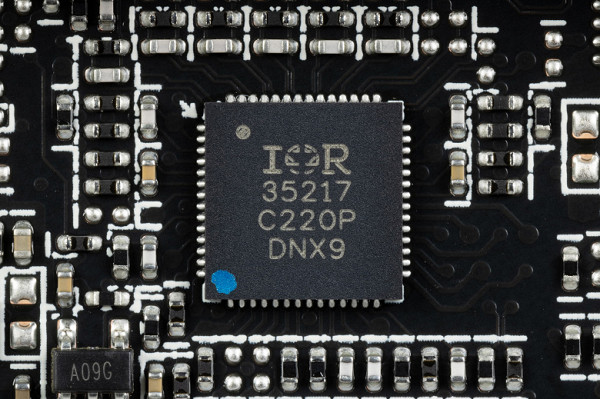
The core power converter has 2 streams, using DrMOS transistor assemblies — in one stream there are 6 pieces of Alpha&Omega AOZ5276QI (90 A), in the second stream there are 2 pieces of On Semi NCP302045 (45 A).

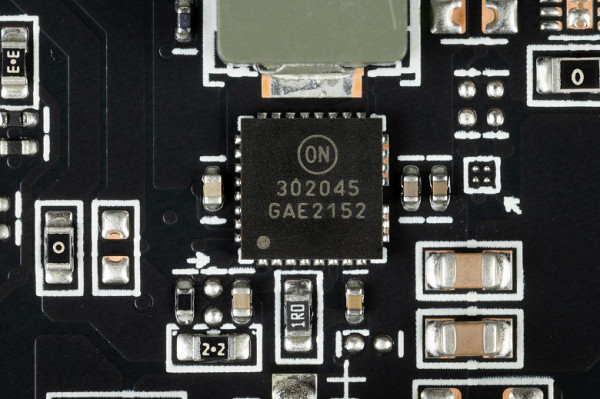
The power supply for the memory chips is controlled by the NCP81022 PWM controller (On Semiconductor).
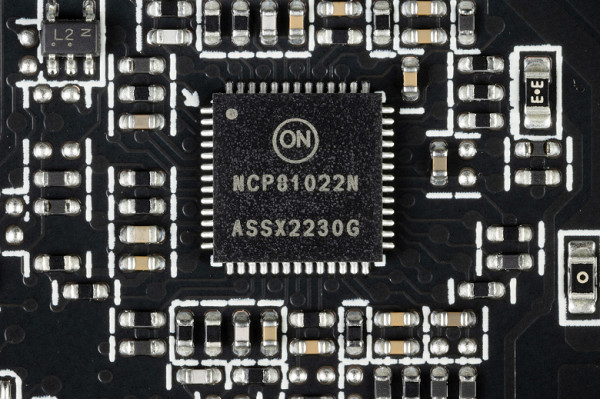
There are also 2 threads, each with 1 phase, where DrMOS assemblies are used: On Semi NCP302045 (45 A) and NCP302155 (55 A).

The graphics card does not have a separate controller for monitoring such as voltage and temperature monitoring. All these functions are performed directly by the GPU. The card has a simple backlight, but is controlled through a traditional Holtek processor.

Standard memory frequencies correspond to reference values. However, the core boost frequency was increased by 2.5% compared to the reference value, which led to an average performance increase of 2% for the Gigabyte card.
The power consumption of the Gigabyte card in tests reaches up to 204 W.
Power for the Gigabyte card is provided via two standard 8-pin PCIe 2.0 connectors.

On the reverse side of the connectors there are LEDs that indicate power problems. If they go out after connecting the power, then there is no problem.
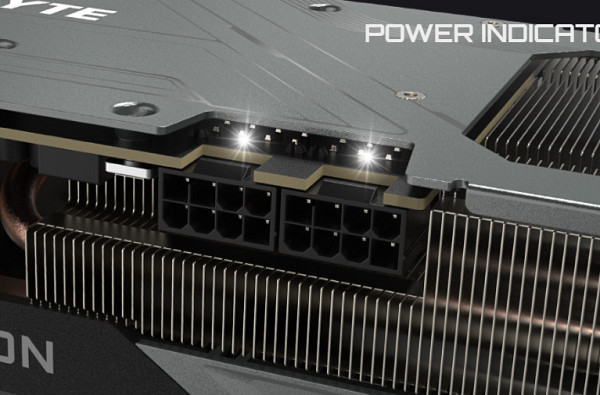
The overall dimensions of this card are small, but the thickness is 5.3 cm, so the video card occupies 3 slots in the system unit.

The card's operation is controlled using the proprietary Gigabyte Control Center utility.
Heating and cooling
The basis of the CO is a multi-section nickel-plated radiator with heat pipes pressed directly into the base in direct contact with the GPU.
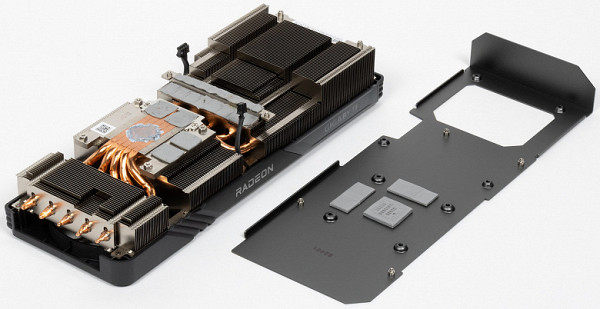
The same radiator also serves as a cooler for memory chips through a thermal interface. The components of the VRM power converters are also cooled (through separate heat sinks).
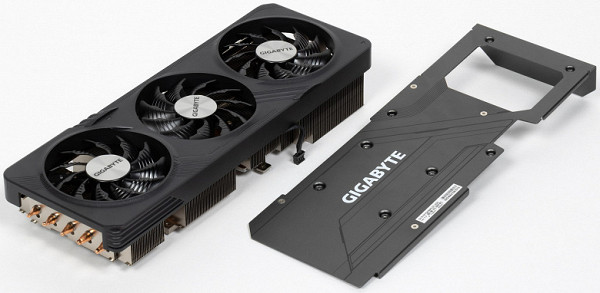
The back plate is made of aluminum with an electrically insulating coating and serves two functions: it serves as a protective element for the printed circuit board (PCB) and, through a thermal interface, helps cool the PCB in the area of the GPU and memory chips. In addition, there is a hole in the back plate for ventilation of the radiator by one of the fans.

Above the radiator there is a casing with three fans with a diameter of 80 mm, which have a special blade profile that directs the air flow in the desired direction.
The central fan rotates in the opposite direction compared to the outer ones, which creates a kind of “gear effect” and helps cope with turbulence in the air flow.
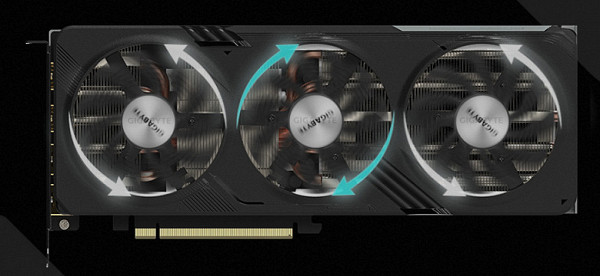
Under low load, the fans automatically turn off as soon as the GPU temperature drops below 50 degrees. This makes the video card operate completely silent. When the computer starts, the fans are activated, but after loading the video driver, they turn off as the system begins monitoring the operating temperature.
Temperature monitoring:
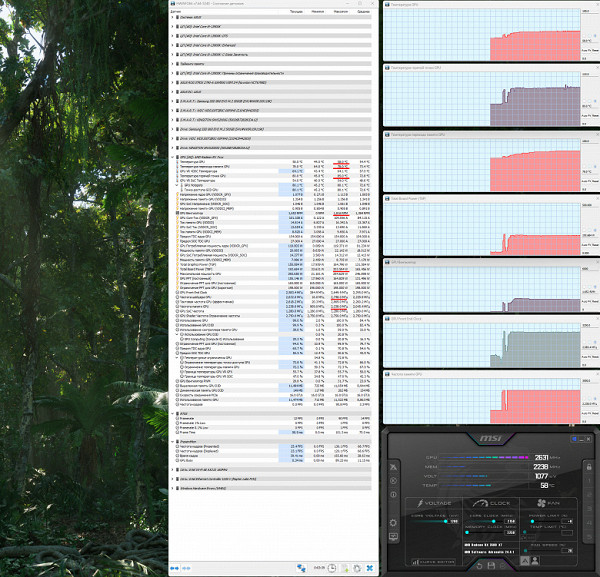
After a two-hour load test, the maximum core temperature was 58 degrees Celsius, with the highest hot spot reaching 85 degrees Celsius, and the memory chips reaching 78 degrees Celsius. These results are very satisfactory for video cards of this level. The power consumption of the card reached 204 W. It should be noted that AMD drivers set the maximum allowable hot spot temperature at 110 degrees Celsius, which is a critical value for adjusting the GPU frequency.
We recorded and sped up 50 times an 8-minute heating test.
Maximum heating was observed in the central part of the PCB, as well as near the power connectors.
Noise
When carrying out noise measurements, it is taken into account that the room is soundproofed and attenuated, and reverberations are reduced. The background noise level is 18 dBA, which corresponds to the noise level in the room and the noise level of the measuring instrument. Measurements are taken at a distance of 50 cm from the video card at the level of the cooling system.
Measurement modes include:
- Idle mode in 2D: an Internet browser with the site iXBT.com, a Microsoft Word window and a number of Internet communicators are turned on.
- 2D Movie Mode: Uses SmoothVideo Project (SVP) for hardware decoding with intermediate frame insertion.
- 3D mode with maximum load on the video card: FurMark test.
The noise level is assessed as follows:
- Less than 20 dBA: relatively silent.
- 20 to 25 dBA: very quiet.
- From 25 to 30 dBA: quiet.
- From 30 to 35 dBA: clearly audible.
- From 35 to 40 dBA: loud, but tolerable.
- Above 40 dBA: very loud.
In idle mode in 2D, the temperature did not exceed 38 degrees Celsius, the fans did not activate, and the noise level was consistent with the background — 18 dBA.
When watching movies with hardware decoding, the noise level remained unchanged.
In maximum load mode in 3D, temperatures reached 58/85/78 degrees Celsius (core/hot spot/memory). The fan speed increased to 1816 rpm, which caused a noise level of 31.7 dBA. It is still considered clearly audible, but not loud.
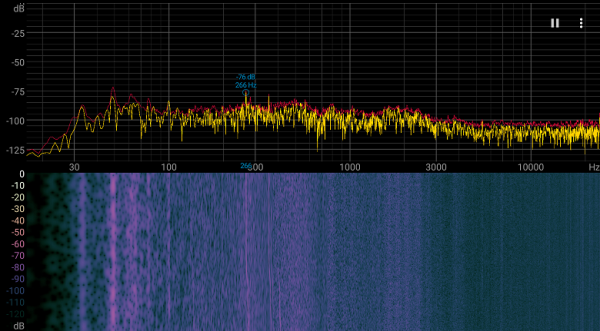
Backlight
The video card has a modest backlight in the form of a logo on the top.
Backlight modes are controlled, including turning it off, through the Gigabyte Control Center utility. Several modes are available, as well as the ability to synchronize the backlight with Gigabyte motherboards.

Delivery and packaging
In addition to the map, the package contains only a short user manual.
Testing: synthetic tests
3DMark Vantage tests
We continue to analyze legacy synthetic benchmarks from 3DMark Vantage, such as the DirectX 10 Feature Benchmarks, which continue to provide valuable data that helps us make useful conclusions when comparing new graphics cards.
One such test is Feature Test 1: Texture Fill. This test measures the performance of texture fetch blocks. It estimates the rate at which a rectangle is filled with values read from a small texture using multiple texture coordinates that change every frame.

Futuremark's texturing test results typically demonstrate strong performance from AMD and Nvidia graphics cards. However, sometimes there are slight discrepancies between the obtained results and the theoretical parameters, especially for some GPUs, where performance may be slightly underestimated.
When analyzing the performance of the Navi 33 GPU in the full version texture test, we see that the results were lower compared to the previous generation RX 6700 XT, which is in line with expectations. However, it is not very clear why the XT version was even slightly inferior to the regular version, given the higher GPU frequency.
Comparisons with competitors also did not show very successful results. The performance of the new Radeon family in the texturing test has decreased slightly, which can be seen in the test results of the RX 7000. As a result, the RX 7600 XT shows performance on par with the RTX 4060, while the RTX 4060 Ti shows higher scores.
The second test, the fill rate test, involves using a simple pixel shader without any performance limitations. This test writes an interpolated color value to an off-screen buffer using alpha blending. A 16-bit off-screen buffer of the FP16 format is used, which makes the test modern and relevant.
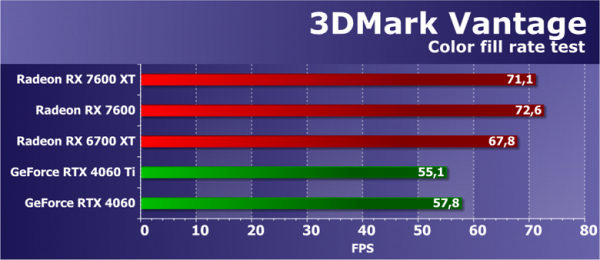
The results of the second subtest of 3DMark Vantage demonstrate the performance of ROP units, without taking into account the amount of video memory bandwidth. This test measures the performance of the ROP subsystem, in which memory bandwidth typically does not have a significant impact. Therefore, it is a little surprising that the Radeon RX 7600 XT video card again performed slightly worse than the younger model with the same GPU, but with a lower frequency. However, today's hero slightly outperforms the previous generation's RX 6700 XT.
Comparison with GeForce RTX 40 series video cards showed noticeably lower performance. Both GeForce lags behind by more than 20%, even the more expensive RTX 4060 Ti. This is quite expected, since Nvidia video cards have always been inferior to their competitors in terms of peak scene fill rate.
The third test — Parallax Occlusion Mapping — is one of the most interesting feature tests, since the Parallax Occlusion Mapping technique has been used in games for a long time. This test draws a single quadrilateral using a sophisticated Parallax Occlusion Mapping technique to simulate complex geometry. It uses resource-intensive ray tracing operations and a high-resolution depth map, as well as a complex shading algorithm. The test is very complex for a video chip, containing numerous texture samples during ray tracing, dynamic branching and complex lighting calculations.
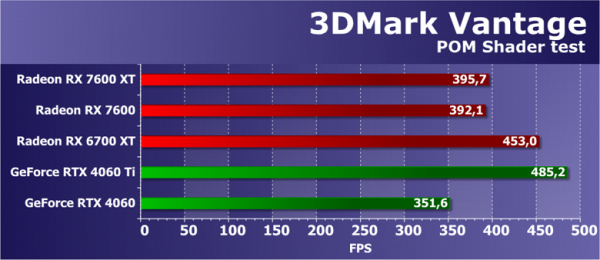
The results of this test from the 3DMark Vantage package depend not only on the speed of mathematical calculations, the efficiency of branch execution or the speed of texture fetches, but also on several other parameters at the same time. To achieve high speed in this task, the correct balance of the GPU is important, as well as the efficiency of executing complex shaders. This test is a fairly useful tool, as its results often correlate with what can be expected in real-life gaming scenarios.
Both mathematical and texture performance are important, and memory bandwidth, although important, does not play such a decisive role. In this “synthetics” from 3DMark Vantage, the Radeon RX 7600 XT model showed results slightly higher than the level of the younger model in the entire family. The RX 6700 XT model from the previous generation, although it is ahead, is not that much. Compared to its competitors, the younger GeForce RTX 4060 is slightly behind, while the more expensive RTX 4060 Ti model has become the leader.
The fourth test, GPU Cloth, is interesting because it calculates physical interactions (cloth simulation) using the GPU. The test uses vertex simulation, combined vertex and geometry shaders, and stream out to transfer vertices between simulation passes. Thus, the execution performance of vertex and geometry shaders, as well as the stream out speed, are tested.
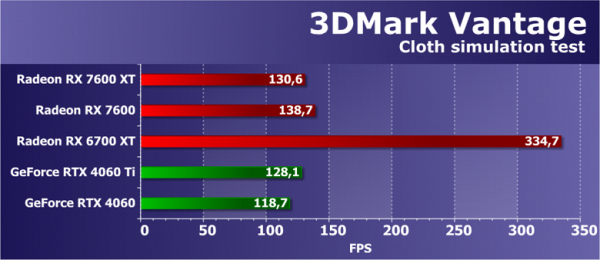
Rendering speed in this test also depends on several parameters, with geometry processing performance and geometry shader execution efficiency being the main influencing factors. While the strengths of Nvidia's chips should have been evident, the results in this test have long been inaccurate, as they often produce incorrect data. This is because the drivers for Nvidia graphics cards, as well as the newer AMD drivers for current generation GPUs, are not optimized to work with such an ancient test suite.
Feature Test 5: GPU Particles
This test is a physics simulation of effects based on particle systems that are calculated using the GPU. The test uses a vertex simulation, where each vertex represents a separate particle. Stream out is used to transfer data between simulation stages. The test calculates several hundred thousand particles, each of which is animated separately, and also calculates their collisions with the height map. To render particles, a geometry shader is used, which creates four vertices from each point, thereby forming a particle. This test especially loads the shader units with vertex calculations and tests the work of stream out.
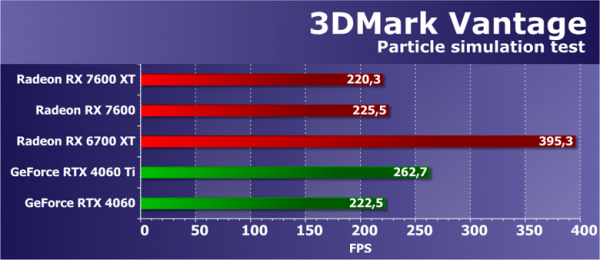
Here we are faced with a similar situation: in the second geometry test from 3DMark Vantage, the results of the new video card are far from expected, although they are already closer to reality than in the previous test. The only correct results were obtained for the previous generation Radeon RX 6700 XT video card, while other models showed results that differed significantly from those expected by theory. The AMD video card reviewed today showed performance approximately at the level of the younger model RX 7600 and the youngest of the competitor’s video cards presented in the comparison, while the RTX 4060 Ti was slightly ahead.
Feature Test 6: Perlin Noise
Vantage's latest feature test is a mathematically intensive GPU test that calculates several octaves of Perlin noise in a pixel shader. Each color channel uses its own noise function to increase the load on the video chip. Perlin noise is a standard algorithm widely used in procedural texturing, and it requires a significant amount of math.

In this mathematical test, the performance of all solutions, although not fully consistent with theory, is usually close to the peak performance of video chips in extreme tasks. The test uses floating point operations, and the new architectures of Ada Lovelace and RDNA3 should have revealed some of their unique capabilities for double execution of corresponding instructions, but this test is already outdated and is not fully capable of showing the new capabilities of modern GPUs, judging by the comparative results.
Despite our surprise, the XT model again failed to beat the lower-end graphics card on the same chip — the Radeon RX 7600, and the results in Vantage as a whole are called into question. Both solutions based on the Navi 33 GPU outperformed the RX 6700 XT from the previous generation, which can be considered a positive result. However, what is even more important is that the RX 7600 XT we are reviewing today has overtaken its younger rival in the form of the RTX 4060, although the RTX 4060 Ti was ahead of everyone — but it is also more expensive than other video cards. Let's see what happens in more modern synthetic tests that use increased GPU load.
Direct3D 12 tests
We decided to exclude from our tests examples from Microsoft's DirectX SDK and from AMD's SDK that use the Direct3D12 graphics API, since they have long demonstrated incorrect results in most cases. Instead, the well-known Time Spy benchmark from 3DMark remained as the only computational test with Direct3D12 support in this section. We are interested not only in the general comparison of GPUs in terms of power, but also in the difference in performance with the asynchronous computing capabilities provided in DirectX 12 enabled and disabled. For reliability, we tested the video cards in two graphics tests at once.
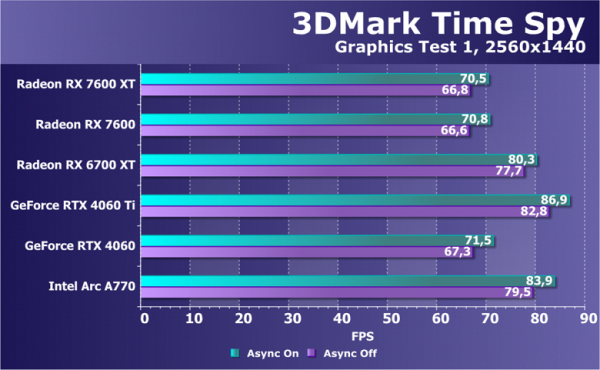

In this test, Radeon video cards usually look better than their GeForce competitors at the price, which is something to take into account. However, this time the performance of the Radeon RX 7600 XT turned out to be slightly lower than that of the younger RX 7600, despite the increased CPU frequencies and sufficient video memory. The RX 7600 XT was only marginally ahead of its smaller rival, the RTX 4060, in one test, while the RTX 4060 Ti and the Intel graphics card were noticeably faster than both Radeons. Compared to other Radeon graphics cards of two generations, the results are also strange. Memory bandwidth is important, which has not changed in the XT, so the older model is not faster than the RX 7600. By the way, the RX 6700 XT turned out to be faster, ahead of both models on Navi 33. This indicates that the RX 7600 XT is unlikely to be significantly more powerful than the RX 7600 in all games, and the previous generation GPU is not much inferior in speed.
Ray tracing tests
One of the first tests of ray tracing performance is the Port Royal benchmark from the creators of the famous 3DMark series. This test is supported by all GPUs with the DirectX Raytracing API. We tested several video cards at 2560x1440 resolution and various settings, including modes where reflections are calculated using ray tracing, as well as traditional rasterization.

The Port Royal benchmark demonstrates several new uses of ray tracing via the DXR API. It uses algorithms to create reflections and shadows using ray tracing, although the test itself is not very optimized and puts a significant load on even powerful GPUs. However, for comparing the performance of different GPUs in this particular task, this test is quite suitable.
The test results clearly demonstrate the difference in the approaches of AMD, Nvidia and Intel to supporting hardware acceleration of ray tracing. Despite some improvements in the RDNA3 architecture, AMD solutions are inferior to competitors. For example, the Arc A770 and RTX 4060 Ti are faster than Navi 33-based graphics cards, including the new Radeon RX 7600 XT.
Later, another subtest of 3DMark was released, focused on testing ray tracing performance — DirectX Raytracing. Unlike the previous one, this subtest does not use rasterization and focuses entirely on ray tracing. This allows you to more accurately estimate the speed of GPU hardware acceleration. The scene in this benchmark uses the familiar BVH structure, which in theory could fit into the Infinity Cache and help Radeon video cards.

In the Speed Way test, added to 3DMark after the release of new generations of Nvidia and AMD GPUs, RDNA3 performed better at ray tracing, although the difference compared to competitors from Nvidia and Intel remained noticeable. The RX 7600 XT turned out to be slightly faster than the RX 7600, but could not outperform even the lower-end Ada Lovelace model, such as the RTX 4060. However, it is worth remembering that this is a synthetic test and may not fully reflect real-world GPU usage conditions.
In real games where ray tracing is used less intensively, the Radeon RX 7600 (XT) can perform much better. However, in such tests, Nvidia and Intel graphics cards can still maintain an advantage due to more efficient implementation of ray tracing hardware units. Their RT cores do most of the work and are more versatile, giving them more consistent performance when ray tracing is enabled.
Speed Way is a more realistic test that stresses various GPU units, making it more interesting for evaluating performance in the context of using ray tracing in games.

In this test, not only computing performance plays an important role, but also memory bandwidth. The RX 7600 XT showed results approximately on par with the RX 7600, but outperformed the younger model in 4K resolution thanks to double the amount of video memory. However, at 12 FPS the question of playability remains open. The difference between Radeon and GeForce/Arc has narrowed, and the AMD video card in question is already inferior to the Arc A770 and the younger GeForce RTX 4060 model a little less, which is a positive result.
Now let's turn our attention to another semi-synthetic benchmark based on a real game engine. Boundary is a Chinese game project that supports DXR and DLSS technologies. This benchmark puts a lot of stress on the GPU, making heavy use of ray tracing for complex reflections, soft shadows, and global illumination. Unfortunately, we are unable to use DLSS technology in our Radeon tests.
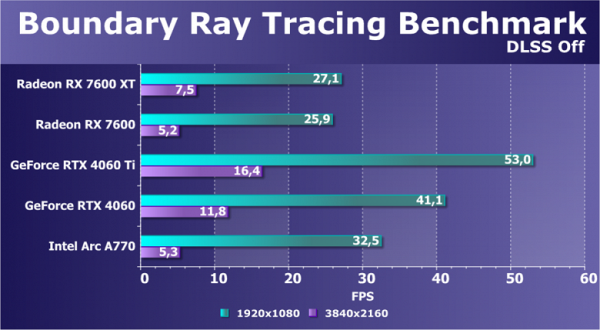
Even in Full HD resolution, only sufficiently powerful video cards, starting from the RTX 4060 Ti level and higher, show acceptable performance without scaling technologies. However, the video card model we are reviewing today demonstrates a frame rate of only 27 FPS, which, although better than the RX 7600 on the same chip with half the amount of video memory, still does not allow it to be included in this list. It lags behind both GeForce video cards presented in the comparison, including the RTX 4060, which costs less. However, it should be noted that the AMD model looks even better compared to the Intel solution — although the latter is faster in Full HD, the difference is not so great, and is even inferior in 4K.
Computational tests
We continue to look for benchmarks that use OpenCL for modern computing tasks to add to our synthetic benchmark suite. Currently in this section there is a rather old and not very optimized ray tracing test — LuxMark 3.1. This cross-platform benchmark based on LuxRender uses OpenCL.

The Radeon RX 7600 XT video card, based on the Navi 33 graphics processor, demonstrated results almost at the level of the younger RX 7600 model on the same GPU, which is surprising — the increased frequency gave almost no performance gain. In all subtests, the results of this AMD graphics card were lower than the competition — even when compared with the less expensive RTX 4060, not to mention the Ti version. It is especially noticeable that the RX 7600 XT cannot compete with the Arc A770 from Intel — the Intel graphics card demonstrated almost twice the performance and is the leader in this test.
Unfortunately, another benchmark for GPU ray tracing performance without hardware acceleration, V-Ray Benchmark, does not support new AMD graphics cards. However, Maxon recently released Cinebench 2024, a new version of the popular 3D rendering benchmark. Cinebench 2024 is based on the 3D graphics and animation software Cinema 4D and uses the Redshift rendering engine. This benchmark allows you to evaluate the hardware capabilities of both the processor and video card by rendering a photorealistic scene. It is important that the same algorithms and scenes are used for testing, which allows you to compare the results for both the CPU and GPU.

In this test, the Radeon RX 7600 XT did not perform particularly well, although it outperformed the lower-end model on the same Navi 33 GPU. Both cards are slightly inferior to the RX 7700 XT, but compared to competing Nvidia video cards, the Radeon's results leave much to be desired — even the RTX 4060 showed one and a half times higher speed than the RX 7600 XT, and the RTX 4060 Ti was even more than twice as fast! Doubling the instruction rate of the new RDNA3 graphics architecture does not seem to have a significant impact in this test. Despite the high theoretical performance, the computing speed of the GPU of the new architecture in real tasks leaves much to be desired.
Tests of DLSS/XeSS/FSR technologies
In this section, we analyze additional performance enhancement techniques associated with resolution scaling technologies. Previously, these were exclusively resolution scaling technologies such as DLSS 1.x and 2.x, FSR 1.0 and 2.0, and DLSS 3, which includes intermediate frame generation. Since DLSS only runs on Nvidia GPUs, and we're looking at a Radeon graphics card today, let's move straight to XeSS, developed by Intel.
XeSS is a performance improvement technique that relies on rendering at a low resolution and then upscaling the image to a higher quality. This method, similar to DLSS 2.0, also uses artificial intelligence to restore detail in the frame. The difference between XeSS and DLSS is that XeSS runs on all modern GPUs, although not as efficiently as on Intel video cards. For testing, we used a specialized benchmark from the 3DMark package.

Enabling XeSS significantly increases the frame rate — up to two times or more. This technology, due to its versatility, deserves attention, since all three companies have their own methods and blocks for accelerating productivity. However, each of them has its drawbacks: DLSS is the most advanced, but only works on Nvidia; FSR is universal, but simple and does not yet use specialized blocks; XeSS is good and versatile, but inferior to DLSS in both quality and functionality.
The Radeon RX 7600 XT model in this test demonstrates approximately the same efficiency as video cards of the previous generation, which is also typical for other modern solutions. Notably, the RX 7600 XT again performs close to the plain RX 7600, which is likely due to the role of memory bandwidth. Nvidia graphics cards perform similarly to AMD in this test, with only Intel's solutions slightly outperforming them thanks to specialized units. As a result, the RX 7600 XT could not beat even its younger competitor RTX 4060 in this test, not to mention more powerful solutions such as the Arc A770 and RTX 4060 Ti.
Another rendering scaling technology is FSR 2.0 from AMD. Interestingly, this particular technology was the last in the list of specialized subtests of 3DMark. Unfortunately, the scenes used by different upscaling technologies differ significantly, and direct comparisons between them cannot be achieved. However, it is possible to compare them based on performance gains, although the actual rendering resolution and quality differences must be taken into account, which is a separate topic for discussion.

FSR is another universal technology that performs roughly the same on different GPUs, so there was nothing unusual in the FSR 2.0 tests — all GPUs placed about as expected. The Radeon RX 7600 XT model also this time showed results at the level of the RX 7600, although in theory it should have been a little faster. However, in this case, the RX 7600 XT is at least not much inferior to the RTX 4060 in most subtests. However, this is modest consolation compared to the results of the RTX 4060 Ti and Arc A770.
In general, the XT model demonstrated the expected results compared to the younger Radeon on the same chip, as well as to competing GeForce and Arc video cards. Without ray tracing, it copes well with the task, although the RX 7600 performed almost identically in most tests. It seems that in some games the performance of the full version of Navi 33 may not be enough to compete with Nvidia and Intel. Moving on to testing the new AMD video card in real gaming conditions will help confirm or refute our conclusions based on synthetic tests.
Testing: gaming tests
Test bench configuration
- Computer based on Intel Core i9-13900K processor (Socket LGA1700) :
- Platform:
- Intel Core i9-13900K processor (overclocked to 5.4 GHz on all cores);
- ZhSO Cougar Helor 360;
- Asus ROG Strix Z790-A Gaming WiFi D4 motherboard based on the Intel Z790 chipset;
- RAM TeamGroup Xtreem ARGB White (TF13D416G5333HC22ADC01, CL22-32-32-52) 32 GB (2×16) DDR4 5333 MHz;
- SSD Intel 760p NVMe 1 TB PCIe;
- SSD Intel 860p NVMe 2 TB PCIe;
- ThermalTake Toughpower GF3 1000W power supply ;
- Thermaltake Level20 XT case;
- operating system Windows 11 Pro 64-bit;
- TV LG 55Nano956 (55″ 8K HDR, HDMI 2.1);
- AMD drivers version 24.4.1;
- Nvidia drivers version 552.22;
- Intel drivers version 101.5445;
- VSync is disabled.
- Platform:
3D gaming performance in a nutshell
Games without ray tracing (classic rasterization):
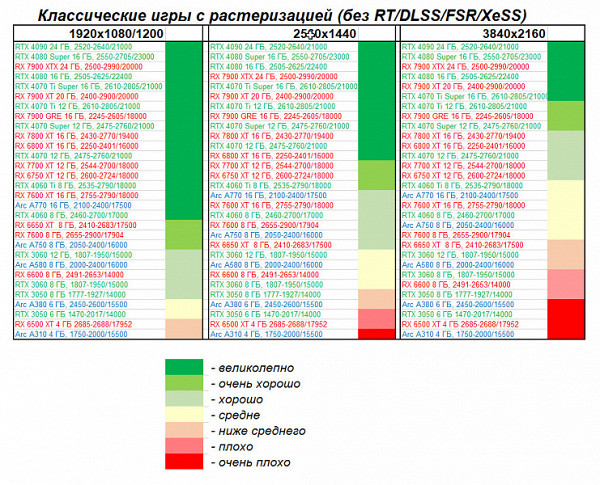
The performance of the Radeon RX 7600 XT is between the GeForce RTX 4060 Ti and the GeForce RTX 4060, slightly inferior to the Radeon RX 6750 XT and roughly on par with the Arc A770. This graphics card provides excellent gaming enjoyment in all games at maximum quality settings at 1080p resolution, and the performance will be quite good at 2.5K resolution. However, this performance may not be enough for 4K gaming, and many games will require lower graphics settings to achieve acceptable gaming smoothness.
Games using ray tracing and DLSS/FSR/XeSS:
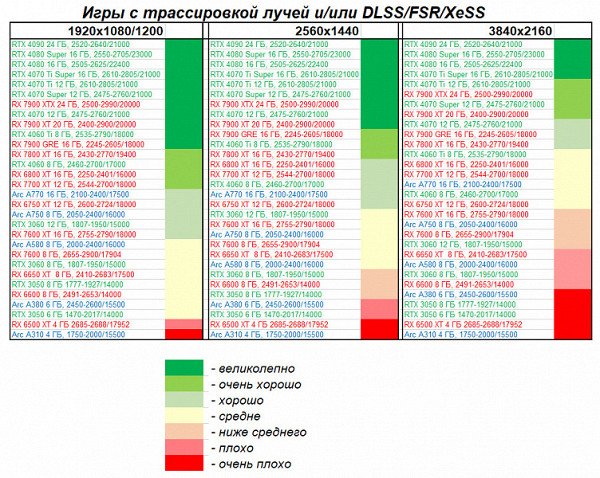
In games that actively use ray tracing and dynamic scaling technologies, the situation changes. Full HD (1080p) resolution becomes borderline, where you can still expect good gaming comfort at high graphics settings. At 2.5K (1440p) resolution, playability may be reduced to a minimum level depending on the specific games. However, 4K resolution in this case becomes practically unattainable. Under these conditions, the Radeon RX 7600 XT demonstrates performance comparable to the GeForce RTX 3060 with 12 GB of video memory, while the GeForce RTX 4060 is significantly superior. Even the Arc A770 is ahead of the Radeon RX 7600 XT, and its rival is the Arc A750.
Conclusions and comparison of energy efficiency
The Radeon RX 7600 XT (16GB) is essentially an upgraded version of the Radeon RX 7600 with double the memory. Both options use the same GPU, with a slight increase in operating frequency and an increase in the power consumption limit to 190-200 W. The increase in memory to 16GB is likely a marketing ploy to differentiate the RX 7600 XT from the base model, as well as to differentiate it from the Radeon RX 7700 XT, which has 12GB of memory.
The opportunity to release an intermediate variant between the Radeon RX 7600 and Radeon RX 7700 XT was noticeable due to the significant difference in performance. One option would be to slow down the Radeon RX 7700 XT by reducing the number of execution units and operating frequency, but leaving the memory controller unchanged, which would allow 12 GB of memory on a 192-bit bus. However, AMD chose a different approach. Instead, they took the off-the-shelf Navi33 GPU from the Radeon RX 7600 and increased the power limit, creating a performance difference between the two models.
Overall, most of the Radeon RX 7000 lineup requires price adjustments, especially given the advent of competing DLSS 3 technology. The introduction of similar FSR 3 technology should improve the position of AMD accelerators, but so far it has been slow. In games without RT, the Radeon family looks quite good, but with RT, Nvidia's solutions take the lead. In classic games, the Radeon RX 7600 XT sits between the GeForce RTX 4060 Ti and GeForce RTX 4060, but with RT and AMD upscaling technologies, AMD's performance drops dramatically, making the GeForce RTX 4060 a more attractive choice. AMD fans can only wait for an adequate price reduction.

By the time we prepared our review, the Radeon RX 7600 XT had been available for purchase for a long time, and we draw conclusions based on real prices. As noted above, at the moment their prices are clearly inflated.
When it comes to energy efficiency, the leaders here are the GeForce RTX 4060 and GeForce RTX 4060 Ti, while the Radeon RX 7600 XT is significantly behind them.
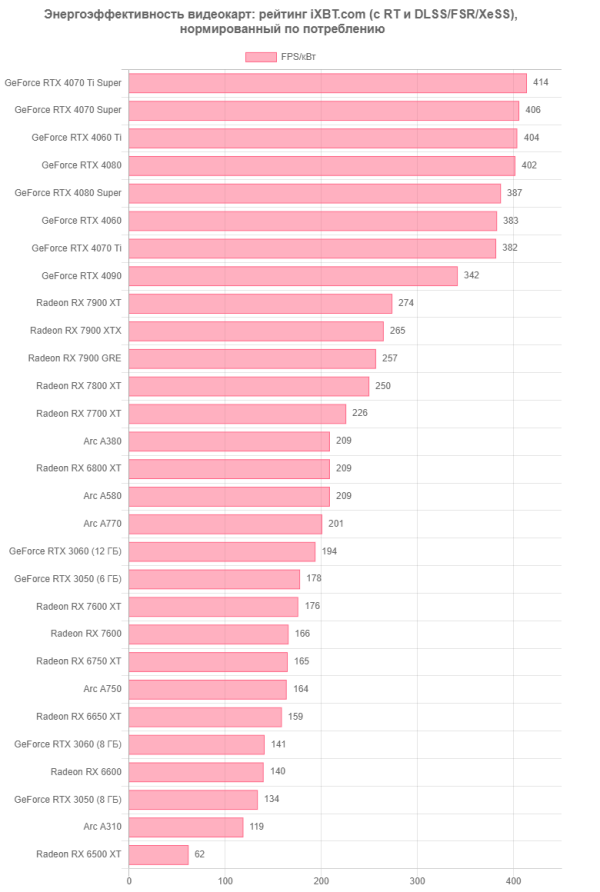
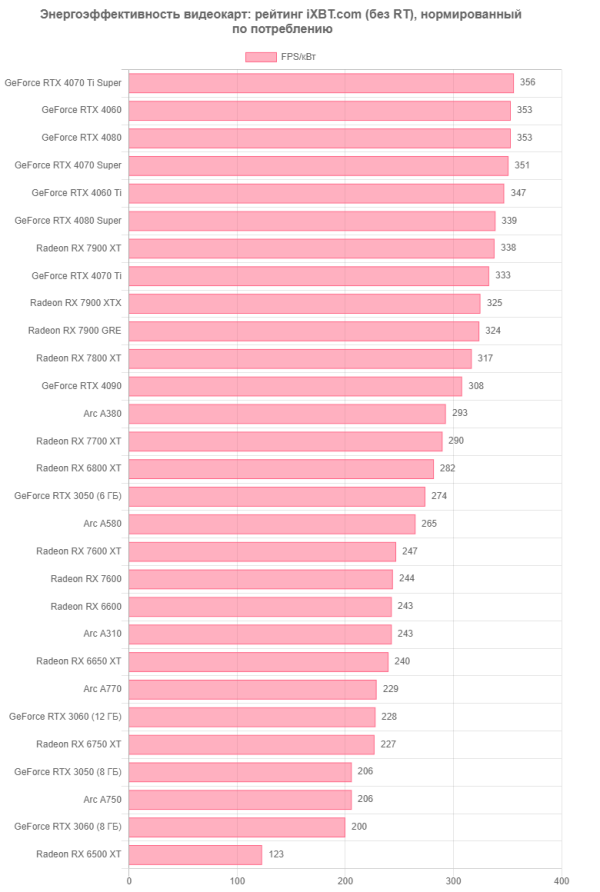
The Radeon RX 7600 XT video card, like older models in the line, is based on the modern RDNA3 architecture. Its compute units are similar to older models and have improved ray tracing cores, as well as the ability to accelerate artificial intelligence tasks. The new product uses a monolithic crystal of the Navi 33 chip, since for simple GPUs the chiplet organization does not make sense. The 6nm process technology for the low-end GPU did not greatly improve power efficiency compared to the previous generation, but it did reduce production costs for AMD.
The output subsystem across the Radeon RX 7000 family has been improved, including DisplayPort 2.1 UHBR13.5 connectors, giving it an advantage over GeForce's limited DisplayPort 1.4a capabilities. This allows you to output 4K at 240Hz without streaming compression over a single cable. The card also has hardware capabilities for video encoding and decoding, including full support for the AV1 format.
The tested Gigabyte Radeon RX 7600 XT Gaming OC 16G (16 GB) model is relatively compact by modern standards, but still occupies three slots in the system unit. The cooling system is not too noisy, and the card can consume up to 200 W and has two standard 8-pin power connectors.
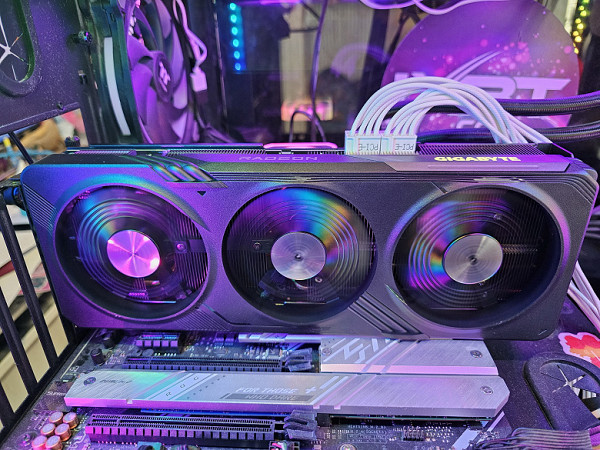
The manufacturer provides a 4-year warranty for this card, subject to mandatory registration of the product on the manufacturer's website.
As already noted, the Radeon RX 7600 XT provides excellent gaming comfort at maximum quality settings at 1080p resolution with ray tracing and scaling technologies disabled. At 2.5K (1440p) you can also expect good FPS, although you may need to lower your graphics settings a bit or disable ray tracing. However, this performance may not be sufficient for 4K resolution.
In games that actively use ray tracing and scaling technologies, at high graphics settings, a comfortable gaming experience can only be obtained in Full HD resolution (1080p). At 2.5K (1440p) resolution, you may need to reduce graphics settings or disable ray tracing.

